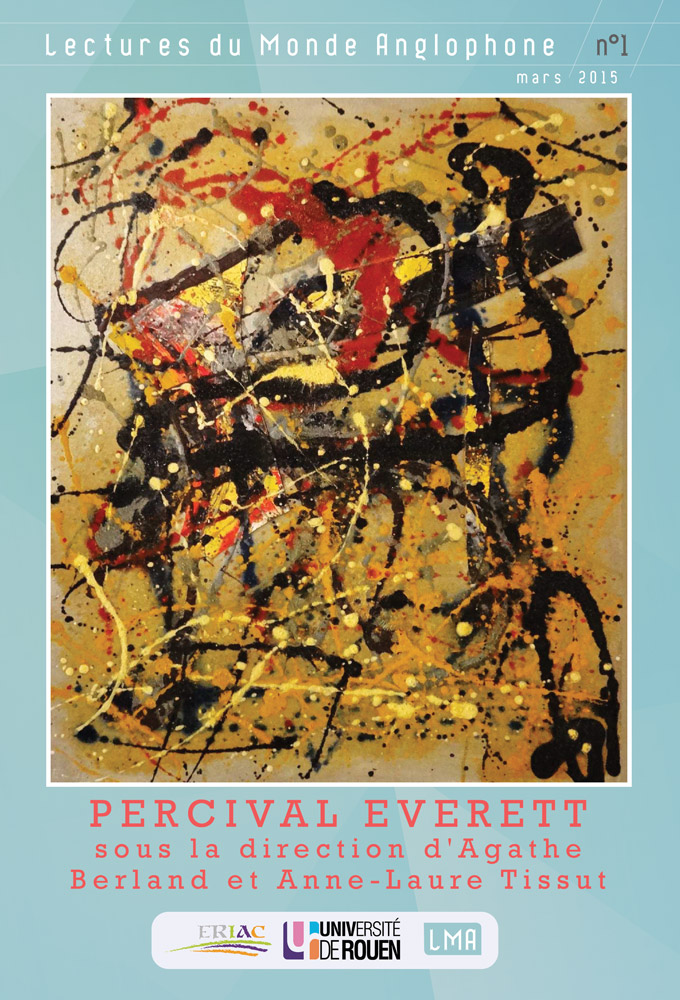Sommaire
1 | 2015
Percival Everett
Ce volume recueille les communications présentées lors du colloque international « Percival Everett » organisé par l’équipe, à l’initiative d’Agathe Berland et d’Anne-Laure Tissut, en mars 2013 à la Maison de l’Université de Mont-Saint-Aignan.Textes recueillis par Agathe Berland et Anne-Laure Tissut, et mis en forme par Sarah Boulet. This volume gathers the papers given at the international conference “Percival Everett” organised by the ERIAC research center and managed by Agathe Berland and Anne-Laure Tissut, that took place in March 2013 at the Maison de l’Université in Mont-Saint-Aignan.Texts collected by Agathe Berland and Anne-Laure Tissut, and finalized for publication by Sarah Boulet.

- Anne-Laure Tissut Introduction
- Keith B. Mitchell Encountering the Face of the Other: Levinasian Ethics and Its Limits in Percival Everett’s God’s Country
- Marguerite Déon Clichés and cultural icons in Percival Everett’s fiction
- Anthony Stewart Talking About Race, Exposing The Desire for the Post-Racial, and Percival Everett’s Assumption
- Claude Julien Assumption: from reminiscences to surprise, from dream to nightmare
- Isabelle Van Peteghem-Tréard Jouissance in Damnedifido stories by Percival Everett
- Clément-Alexandre Ulff Invisible Fathers: Investigating Percival Everett’s “Lower Fresquencies”
- Michel Feith The Well-Tempered Anachronism, Or The C(o)urse of Empire in Percival Everett’s For Her Dark Skin
- Judith Roof Everett’s Eidolon: The Story of an Eye
- Brigitte Félix “Of weeds and words: Percival Everett’s poetry”
- Claudine Raynaud Naming, Not Naming and Nonsense in I am Not Sidney Poitier
- Françoise Sammarcelli Vision and Revision in Percival Everett’s Erasure
- Marie-Agnès Gay "Wanted: straight words" in Percival Everett’s novel Wounded
- Sylvie Bauer “Private Terbulent Seas”: “painting The Moon” In Cutting Lisa, By Percival Everett
- Gwen Le Cor “At any rake,” angles of “linguistic condensation” and shock in Percival Everett’s The Water Cure: “All this while we play and pain with a language that is private.”
1 | 2015
The Well-Tempered Anachronism, Or The C(o)urse of Empire in Percival Everett’s For Her Dark Skin
Michel Feith
An irreverent revisiting of the myths of Medea and the Argonauts, For Her Dark Skin (1990) is Percival Everett’s first Signifyin(g) on classical myth, characterized by a playful recourse to anachronism. On the lighter side, the transposition of epic and tragedy into a mundane world reminiscent of small-town, or suburban, American amounts to a mildly self-reflexive breaking of the frame, debunking the prestige of the Classics and reminding us of the fact that all readings of the past are anchored in the present. Yet, the title warns us that anachronism cannot be limited to this light-tempered humor: the fact of racializing the myth’s confrontation between Greece and its barbarian Other, forges a parallel between the course of Empire in ancient myth and the history of imperialism in America. A backward gaze at a much-idealized Greece, the forebear of Western philosophy and democracy, may lead us to reconsider the status of one (or two) system(s) that indulged in expansionism and slavery. “Race” is a myth, just as the story of Jason and Medea is. Their nature is different, one being a social fiction, and the other a literary one; yet both toy with the line separating civilization from barbarism. The symbolic power of a canonic work can perpetuate ideologies in a covert fashion, just as the power of ideologies can warp our reading of canonic works. Critical Signifyin(g) on the Classics may therefore be equivalent to a mental deprogramming cure, a sort of “verbal rehab,” so to speak.
Ce texte n’a pas encore fait l’objet d’une rétroconversion en XML, mais il peut être consulté dans sa version PDF.

Ce(tte) œuvre est mise à disposition selon les termes de la Licence Creative Commons Attribution - Pas dUtilisation Commerciale - Partage dans les Mêmes Conditions 4.0 International. Polygraphiques - Collection numérique de l'ERIAC EA 4705
URL : https://publis-shs.univ-rouen.fr/eriac/521.html.
Quelques mots à propos de : Michel Feith
Université de Nantes – CRINI
Michel Feith is Associate Professor in American Literature at the University of Nantes, France, and a member of Center for Research on National Identities and Intercultural Studies (CRINI). After a doctoral thesis entitled “Myth and History in Chinese American and Chicano Literature” (1995), his publications include articles on Maxine Hong Kingston, Gerald Vizenor, John Edgar Wideman, Percival Everett and the Harlem Renaissance. On the latter subject he edited, with Pr. Geneviève Fabre, Jean Toomer and the Harlem Renaissance (Rutgers University Press, 2001) and “Temples for Tomorrow”: Looking Back at the Harlem Renaissance (Indiana University Press, 2001). He has also edited three collections on nationalism and regionalism at the University of Nantes, the latest one being Nationalismes et régionalismes: Amériques, Modes d’emploi, Nantes, CRINI Editions, 2008. A volume of conference proceedings entitled Paroles de vainqueurs, paroles de vaincus: réécritures et revisions was released in 2012, also at the CRINI.
